The Portrait That Does NOT Depict J. S.
Bach With Three Of His Sons Pages at The
Face Of Bach
Part 2 - Who the Group Portrait Really Depicts
The Face Of Bach
This remarkable photograph is not a computer generated
composite; the original of the Weydenhammer Portrait Fragment, all that remains of the
portrait of Johann Sebastian Bach that belonged to his pupil Johann Christian Kittel, is
resting gently on the surface of the original of the 1748 Elias Gottlob Haussmann
Portrait.
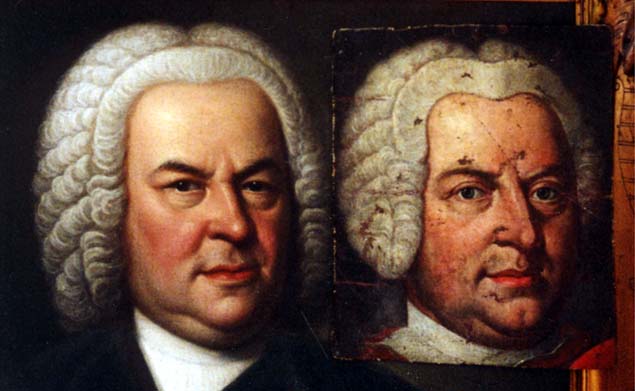
1748 Elias Gottlob Haussmann Portrait, Courtesy of William H. Scheide, Princeton, New Jersey
Weydenhammer Portrait Fragment, ca. 1733, Artist Unknown, Courtesy of the Weydenhammer
Descendants
Photograph by Teri Noel Towe
©Teri Noel Towe, 2001, All Rights Reserved
The Portrait That Does NOT Depict J. S. Bach With Three
Of His Sons
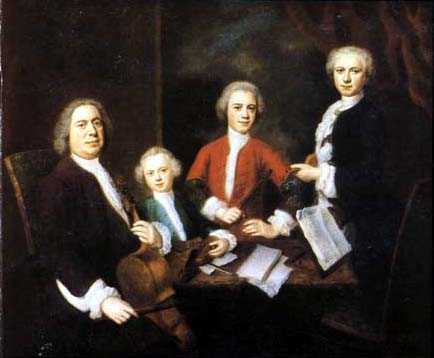
Part 2
Who the Group Portrait Really Depicts!
A Case of Mistaken Identity
Some Preliminary Conclusions About the True Identities of
the Father and Three Sons Depicted in the Group Portrait Attibuted to Balthasar Denner
Part Two
As I implied at the end of the
previous page, after I delivered the bad news about the Group
Portrait, there is good news as well.
If one has any sensitivity, demolition is no joy, unless
one can build on the foundations of the ruins.
And that is precisely what I now intend to do with regard
to the Group Portrait.
Now that I have demonstrated, and not without a certain
sadness, I must admit, that the Group Portrait that surfaced in 1985 does NOT depict
Johann Sebastian Bach and three of his sons, I shall now put forward the compelling
evidence, if not the conclusive proof, for my firmly held belief that the two exemplars of
the Group Portrait depict one of Johann Sebastian Bach's good friends and three of his
sons.
When the astonishment of confronting the Group Portrait for
the first time on the cover of Early Music in the spring of 1985
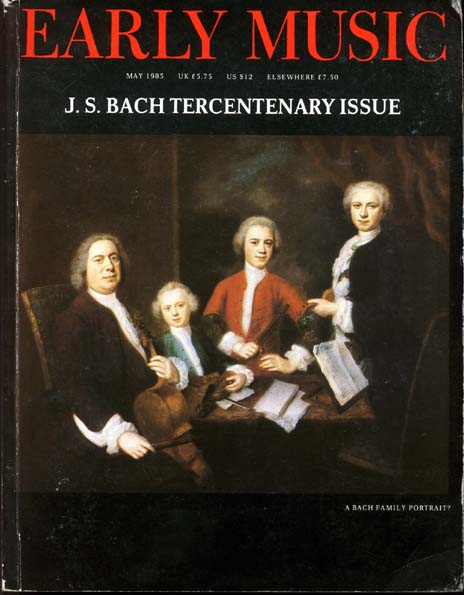 wore off and I began to study the picture, I had one of those reactions about
which Bernard Berenson spoke.
wore off and I began to study the picture, I had one of those reactions about
which Bernard Berenson spoke.
"The first ten seconds with an object," Berenson
said, "are worth the next ten years."
I saw "Bach" holding the 'cello and thought,
"It's not Bach, but is it Christian Ferdinand Abel and three of his sons?"
But I knew next to nothing about Christian Ferdinand Abel
other than (1) he was the court 'cellist in Anhalt-Cöthen while Bach was Capellmeister
there and (2) his son Carl Friedrich Abel (1723-1787) was the greatest viola da gambist of
his generation, and, in fact, the last great viola da gambist until the extraordinary
Arnold Dolmetsch rediscovered the instrument, to be followed about a half a century
thereafter by the late, great August Wenzinger.
As annoying as I found it to see the Group Portrait or a
significant detail from it on the cover of a CD booklet, as annoying as I found it to see
the Group Portrait or a significant detail from it reproduced in a book or a magazine
article with no indication that the identification of the individuals in the image was by
no means certain, I did nothing about it. I did no disciplined research to confirm or to
quash the accuracy of my suspicions. I made a half hearted effort, but when I discovered
that the entries on the Abel family in the then "new" New Grove contained no
family tree, I set the matter aside for a day when I could focus on that and nothing else.
I had other, more important, fish to fry, as the saying
goes.
Still, every time I saw a reproduction of the Group
Portrait, I found myself saying to myself, "Why isn't it Christian Ferdinand Abel and
three of his sons?"
Well, as Pablo Casals used to say, "Things arranged
themselves."
The arrival in my life of the Weydenhammer
Portrait Fragment, which I have proven beyond a reasonable doubt is what remains of the long lost portrait of Johann Sebastian Bach that had
belonged to his pupil, Johann Christian Kittel, changed a lot of things, and the Group
Portrait is one of the things that got changed in the process. Like the Volbach Portrait, but for other reasons, I think, the Group
Portrait has insisted that I confront it, perhaps because the four men who posed for it
want, no matter how long it has taken, to be correctly identified.
Now, finally, I shall respond to their entreaties and do my
best to clear up what I firmly believe is an unfortunate case of mistaken identity.
First of all, I should explain why it is that my instant
reaction to the image was, "Why isn't it Christian Ferdinand Abel and three of his
sons?" (To be candid, I also considered the possibility that it might be Johann
Friedrich Fasch and three of his sons, but a quick review of the the biographical material
on Fasch and his son Carl Friedrich quickly made it clear that that scenario was a factual
impossibility.)
As I pointed out earlier, Christian Ferdinand Abel was an
excellent 'cellist, and he was a colleague of Bach's at Cöthen, where he was the
principal 'cellist in the Hofcapelle; it is alleged that he fell on hard times
after the death of Prince Leopold in 1728, and he was living in severely reduced
circumstances at the time of his death in 1737. (Some sources suggest that Christian
Ferdinand Abel lived from 1682 to 1761, but the materials that I have studied indicate
that the year of death 1737 is the correct one.) A native of Hannover, Christian Ferdinand
Abel joined the Hofcapelle at Cöthen at about the same time that his older
brother, Johann Christoph, became the Head Gardener at the Court, and the first in a long
line of distinguished "Estate Superintendents", horticulturalists, and landscape
architects.
There are many details about Christian Ferdinand Abel's
biography that are intriguing. For example, he served in the Swedish Army, under the
leadership of King Carl XII, and he brought a Swedish bride home to Germany with him. I
cannot help but wonder if, during his years in the Swedish Army, his path crossed that of
Johann Jacob Bach (1682-1722), Johann Sebastian's next older brother, who was an oboist in
the employ of King Carl XII. In any event, Christian Ferdinand Abel and Sebastian Bach
became good friends. Sebastian was the godfather of Abel's daughter, Sophie Charlotte, and
it is very likely that Abel was one of the 'cellists whom Bach had in mind when he
composed the Six Suites for 'Cello Alone, BWV 1007-1012.
Soon after I began to focus on the problem of the Group
Portrait, I had occasion to pay a visit to my alma mater, and while I was at Princeton University for Reunions on June 2, 2001,
with the blessing and encouragement of my dear friend Paula D. Matthews, who is now the
Music Librarian, I spent a couple of hours wandering through the stacks of the Arthur
Mendel Music Library. (God bless the Librarians at Princeton! They steadfastly refuse to
abandon the open stack policy that has prevailed since the beginning!) One of the tomes
upon which I stumbled was a monograph by Walter Knape on Christian Ferdinand Abel's son,
the gambist and composer Carl Friedrich Abel.
I looked through this informative little book, and, to my
astonishment and delight, I discovered that, on page 232, it contains a genealogy table
for the Abel family:

Holding my breath, I studied the family tree, hoping
against hope that it would tell me what I wanted to hear, if you will pardon a lapse into
the conversational.
It did, and the collateral family and biographical
information that Prof. Dr. Knape provides elsewhere in his monograph was more manna from
Heaven.
The pieces of the puzzle finally began to come together.
Please consider the seven children of Christian Ferdinand
Abel and his Swedish born wife, Anna-Christina Holm:
They are:
Leopold August (1718-1794) - a student of Franz Benda, a
violinist of the first rank, and the patriarch of both the English and the German branches
of the family. (Intriguing, isn't it? One of the exemplars of the Group Portrait was in
England and the other was in Germany, according to Christoph Wolff. But I am getting ahead
of myself.)
Ernst August (ca. 1719-1780) - a Kunstmaler, an
artist, a painter by profession.
Sophie Charlotte (born 1720) - the only daughter and the
child for whom Sebastian Bach stood godfather.
Ernst Heinrich (born 1721) - Prof. Dr. Knape gives no
date of death, but, because the second youngest of Christian Ferdinand Abel's sons bore
the same name, I surmise that this Ernst Heinrich died in childbirth or in infancy.
Carl Friedrich (1723-1787) - the famed viola da gambist,
master musician, composer, impresario, and business partner of John Christian Bach.
Ernst Heinrich (born 1725) - According to Prof. Dr.
Knape, the Ernst Heinrich who survived infancy also became a Kunstmaler, an
artist, a painter by profession.
Markus Christian (born 1728) - I so far have no definite
information about the career path that the youngest son may have taken.
Five of the six sons appear to have lived to maturity. Of
those five, certainly two, and perhaps three, if one includes the youngest son, Markus
Christian, became professional musicians, and, true to their heritage, professional
musicians of the highest quality.
Let us consider the implications of the Christian Ferdinand
Abel family tree and how it might "dovetail" with the Group Portrait.

Please assume, arguendo, that the Group Portrait
depicts the 'cellist Christian Ferdinand Abel in the last year or so of his life (assuming
that he did, in fact, die in 1737, not 1761), with the three sons who are planning to
follow in their father's footsteps. You would have, in such a situation, a father in his
middle 50s, an eldest son about 18 or 19, a second son about 12 or 13, and a third son
about 8 or 9. The patriarch and the three sons in the Group Portrait neatly fit the bill,
don't they?
In sum, I contend that the Number One Son, on the right,
holding the violin, is Leopold August Abel. (I wondered if there are any portraits of him
in Ludwigslust or in Schwerin that might provide additional evidence. After all, the
Number One Son does have, at least in the Der Junge Bach version of the Group
Portrait, an overbite that is so prominent that, in this day and age, he would have been
sent to an orthodontist! I have been in touch with the Museum administration in Schwerin
since first posting this page, and I have been informed that there are no portraits of
Leopold August Abel in the collections at Ludwigslust or Schwerin. I have now written and
asked if there are any group portraits of the court orchestra that might contain a
depiction of Leopold August Abel.)
Number Three Son would be Markus Christian Abel, about whom
I so far have no information.
Number Two Son, therefore, is Carl Friedrich Abel.
And, with Carl Friedrich Abel we are fortunate to have a
number of portrait images to study to see if they can in any way either support or refute
my contention that the Group Portrait depicts Christian Ferdinand Abel and three of his
sons. These portrait images show him at ages ranging from 40 to 42, to 64. Nevertheless, I
am convinced that certain aspects of his facial physiognomy, most notably his pronounced
overbite and the distinctive shape of his rather wide nose, are so distinctive that a
"match" can be made.
Let me begin by showing you a caricature that was drawn in
1787, the last year of Abel's life:

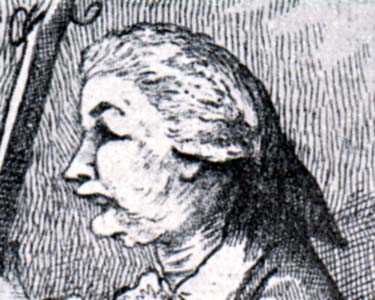
It may be a caricature, but it is a sensitive and
perceptive one, a caricature that make it clear that Carl Friedrich Abel had an overbite,
just like Number Two Son.
The earliest portrait of Carl Friedrich Abel that I have
been able to locate is the charcoal drawing, made by his close friend Thomas Gainsborough,
that served as a preliminary sketch for the first of the two portraits in oil that
Gainsborough is known to have painted of Abel. This image dates from either 1763 or 1765,
depending on which source you choose, and it therefore shows Abel as he looked when he was
40 to 42 years old:

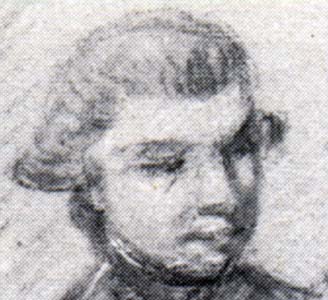
It is not much of a stretch, is it, to conclude that
Gainsborough has sketched Number Two Son. In the following group of examples, as before,
the Bonham's Version is on the left, and the Der Junge Bach version of the Group
Portrait is on the right.



Please note that, even though the pose is slightly
different, just how similar the length and the shape of the right eyebrow are, how the
nose seems to have the same shape, with no ridges or bumps, and the pronounced overbite is
clearly discernible in all three images.
An oil portrait resulted from this sketch. The original is
now in the National Portrait Gallery in
London (one of my favorite museums since I was seven years old! Yes, I have been
obsessed with portraiture for a long time!). According to the information at the NPG website, the portrait is not on
display at the present. (Can you imagine? Having a Gainsborough portrait and not having it
on display?!!) I have so far been unable to find a photograph of the painting that is of
high enough quality to permit the creation of the kind of scans that I need for analysis
of this kind; so, for the present, I am afraid that you will have to take it on faith that
the oil portrait confirms the physiognomical traits that I have described.
The best known of the portraits of Carl Friedrich Abel, and
justifiably so, is the magnificent full length portrait that Thomas Gainsborough painted
in 1777, when Abel was 54. This painting is now in the Huntington Library in San Marino, California,
together with the famous "Blue Boy":
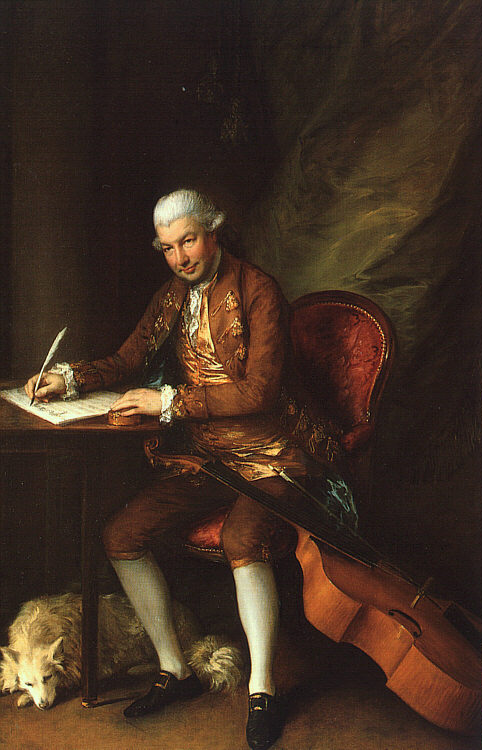
Please forgive me, but the detail of Abel's head from this
portrait is in black and white. Once again, in the following group of examples, as before
the Bonham's Version is on the left, and the Der Junge Bach version of the Group
Portrait is on the right.



While increased age has exacerbated the arch of the
eyebrows, they are still every bit as long, and, the peculiar bulge at the outside end of
the left eyelid, a bulge that can be seen in both versions of Number Two Son, is very much
in evidence in the 1777 Gainsborough portrait. The distinctive shape of the nose is also
in evidence, and, while there may have been a significant loss of teeth, the overbite is
also still very much in evidence.
By the way, I have not gone out onto a limb over the
eyecolor, because of the relatively low resolution or black and white images that have
been available to me, but, tentatively, without having the luxury of high resolution
images of the portraits or having seen any of the originals, except the Gainsborough in
San Marino (and that was 23 years ago!), it appears that Abel and Number Two Son both had
brown eyes.
Let us return to the Group Portrait as an entity again.

Please let me remind you that I am not a musicologist. I
consider myself to be a music historian, and I am trained as an art historian, both
academically and practically. I am a collector, and I am the son of a collector. I do not
mean to be disrespectful of the Berlin art historian Helmut Börsch-Supan who opined that
the Group Portrait is the work of Balthasar Denner.
I admit that my knowledge of Denner's work is not all
encompasssing, but, on the basis of my long "friendship" with the wonderful bust
portrait that Denner painted of Handel in 1728 or thereabouts that is now in the National Portrait Gallery in London, and
having studied Denner's magnificent bust portrait of an unidentified elderly lady that is
now in the Hermitage Museum in St. Petersburg,
I have to say that I cannot agree with the contention that the Group Portrait, no matter
who it depicts, is the work of Balthasar Denner. I have read that he consciously changed
his style as a painter, but, no matter what that change was, I doubt that a painter of his
calibre would have made the "errors" in perspective that are rife in both
versions of the Group Portrait. And, even allowing for the abrasion and damage to the two
canvasses, I must say that the method by which the paint is applied to the surface of the
canvass, the lack of subtlety in the brush strokes, the absence of conviction in the
characterizations, argue cogently against an attribution to Balthasar Denner. Mind you, I
could be wrong about this, and I plan to do a lot more homework on Denner, I assure you,
but for the present, I do not believe for a nano-second that either exemplar of the Group
Portrait is the handiwork of Balthasar Denner.
But it is not beyond the realm of possibility that the
paintings are the handiwork of a Kunstmaler within the immediate family, most
likely Ernst August Abel, who was about a year younger than Number One Son, the violinist
Leopold August Abel. Much ink has been spilled over what the empty chair in the lower
right hand corner is meant to signify, other than acting as a "stopper" to make
the composition of this Group Portrait "complete" and correctly balanced.
Of course, if the vacant chair is meant to symbolize the
son who is painting the picture, why isn't there a second chair for the other son who
became a professional artist and painter? For that question, I have no easy answer, no
facile response. While I delight in the elegant use of acknowledged iconographic
attributes which always had been an essential element of fine art portraiture, I admit
that I am not one well versed in the lore of such symbolism and such symbolic gestures.
Nevertheless, my reaction to the vacant chair is
Toscanini-esque. To him, the opening movement of the Beethoven Third Symphony was
allegro con brio, nothing more and nothing less. To me, the chair in the lower
right hand corner balances the composition of this Group Portrait, nothing more and
nothing less. And it is an appropriate solution to the problem of compositional balance in
the portrait. After all, it can be interpreted as the chair from which Leopold August has
just stood up during a hiatus in a family music making session. In that sense, I can see
the presence of the vacant chair as symbolic.
But as an "attribute" or as a "symbol",
the vacant chair does not have the requisite Bachian precision. The vacant chair does not
signify a learned musician as Christoph Wolff reminds us that the Canon Triplex a 6
vocibus that Bach proffers to the viewer in the 1746 and 1748 Haussmann Portraits does. The vacant chair provides no clue to
the identity of the sitter in the way that the 14 buttons on the waistcoat of a most
unusual design in the Volbach Portrait or the 14 button holes in
the Berlin Portrait do.
Before I leave the topic of the symbols and attributes that
are to be found in the Group Portrait, let me address the potential anomaly involving
Number Two Son. If Number Two Son is Carl Friedrich Abel, virtuoso viola da gambist par
excellence, why is he holding a transverse flute? Carl Friedrich Abel is known to
have been something of a "polymath" instrumentalist. He is known to have played
the harpsichord and the French horn in addition to the gamba. Little is known of the
details of his childhood. Is Carl Friedrich portrayed with a flute in hand because the
flute was the other instrument that he was studying intensively, because he had still not
made up his mind whether to devote his life to the flute or the gamba, and because, at
twelve or thirteen, he was leaning towards the flute rather than the gamba?
The reader will recall that earlier I remarked that Leopold
August Abel was the patriarch of both a German line of descent and an English one.
Christoph Wolff states that one exemplar came from Germany and that the other was in a
private collection in England. [Please see the Addenda at the bottom of the page for more
on the English provenance of the Group Portrait.] Perhaps now that the subjects of the
Group Portrait have been convincingly identified as Christian Ferdinand Abel and three of
his sons, the former owners of the Bonham's Version (or, if the rules of confidentiality
permit it, the powers that be at Bonham's) will disclose the provenance. And I hope the
same will prove true for the other exemplar. If it turns out that either one or both of
these paintings has descended in the family of Leopold August Abel....
Obviously, this report on the Group Portrait that has been
alleged to depict Johann Sebastian Bach and three of his sons is a preliminary report. It
is subject to correction and refinement, as more information becomes available to me, but
I feel confident that my long held surmise will stand the tests to which it will and
should be subjected. Whatever the result, I hope that this prelimiary assessment of the
Group Portrait will prompt more research into the details of the lives of the various
members of the Abel family who, I believe, posed for the painting. Are there any other
portraits of Leopold August Abel, for example? Did the youngest son Markus Christian have
musical talent, and, if so, was he also a violinist? Are there any other authentic images
of Christian Ferdinand Abel that are reliable comparisons?
But, in the absence of cogent evidence to refute my
contentions, the conclusion is clear and unequivocal:
The Group Portrait attributed to Denner depicts Christian
Ferdinand Abel, his eldest son Leopold August Abel, his fourth son, Carl Friedrich Abel,
and his youngest son, Markus Christian Abel.
If my conclusions withstand scholarly scrutiny and are
accepted as accurate and dispositive, the "loss" to the world of a Bach family
group portrait will have been more than compensated for by the addition to the musical
iconography of a portrait of a close friend and colleague of Sebastian Bach's, an
important figure who has stood, hidden in the shadows, for almost 300 hundred years,
waiting patiently for his chance to be known as something other than a name.
Christian Ferdinand Abel, welcome to the world of musical
iconography. Welcome to the world of Bilddokumente zur Lebensgeschichte Johann
Sebastian Bachs. Maestro, your arrival on the scene is long overdue!
Sei gegrüsset! Sei willkommen!
Teri Noel Towe, June 20, 2001
ADDENDUM
My beloved Mother often said that you
found things when you were looking for something else. As it turns out, Ladyboss's maxim has proven
valid yet again, this time in regard to my research on the provenance of the Group
Portrait. Several month's ago the distinguished Bach bibliographer Yo Tomita and the
eminent music historian and authority on the Wesley family of musicians Michael Kassler
honored me by soliciting my help in trying to match existing images of Bach, if possible,
to a couple of images for which there are written references. In the process, we received
information from Oliver Davies at the Royal Society of Musicians that may shed additional
light on the provenance of one of the exemplars of the Group Portrait.
In describing what documentation on Bach portraits so far
has been found in the archives of the Royal Society of Musicians, Mr. Davies writes:
"The Music Loan Exhibition in 1904 showed only a
portrait of JSB 'with three sons' loaned by Mr. A. Kummer."
A request for more specifics that I sent to Michael
Kassler, in the hope that there might be a photograph of the image in question or a
catalogue entry that included the dimensions of the picture, yielded the following reply:
"The reference on p 121 of the catalogue, in a
section labelled 'oil paintings and portraits', reads, in its entirety:
1225. Bach. -- Portrait of a musician and three sons (believed to be the Bach family).
Lent by Mr. A. Kummer."
The description, of course, is vague, to say the least,
but, nevertheless, I cannot help but wonder if this is not one of the two exemplars of the
Group Portrait. Clearly, much more research will have to be done on this point, but I
have, however, found an intriguing clue to the possible identity of Mr. A. Kummer. I have
both the 3rd and the 5th editions of the Grove Dictionary of Music and Musicians
in my library, and, in both, as an addendum to the biography of the 19th century German
'cellist, Friedrich August Kummer, I found the following intriguing entry, provided by
Alexis Chitty, Esq.:
"His grandson (2) ALEXANDER CHARLES [KUMMER] (b.
Dresden, 1850), was trained under David at the Leipzig Conservatorium, and lived for many
years in London in high esteem as a violinist."
The entry in the 5th Edition differs only in offering a ?
for the date of death.
Could it be that this gentleman is the Mr. A. Kummer who
loaned the painting? If so, how did he obtain it, and what became of it after it left his
collection?
Let us hope that further research will yield the answers.
Teri Noel Towe, August 24, 2001
ADDENDUM No. 2
Yet again, things arranged themselves, as Pablo Casals was
fond of saying.
I am now in a position to demonstrate that one of the
exemplars of the Group Portrait was, in fact, exhibited at the Music Loan Exhibition in
1904. I am also able to demonstrate that the version exhibited was the Bonham's Version,
and not the Der Junge Bach version.
Several weeks after I posted the first Addendum to this
discussion, I stopped by The Book Garden in Wickford, Rhode Island to chat with its owner,
Melissa Fischer. Melissa always has second hand books of interest, and that particular
afternoon proved to be no exception. Among the recently acquired stock was a small but
quite thick tome nearly a century old.
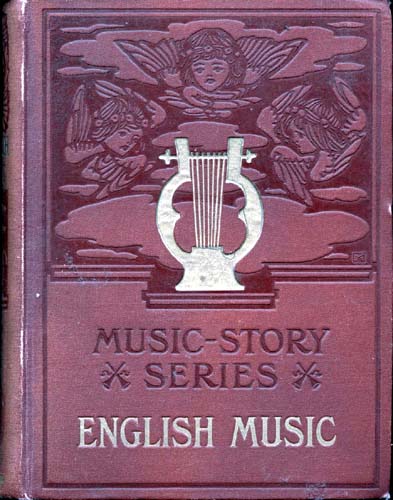
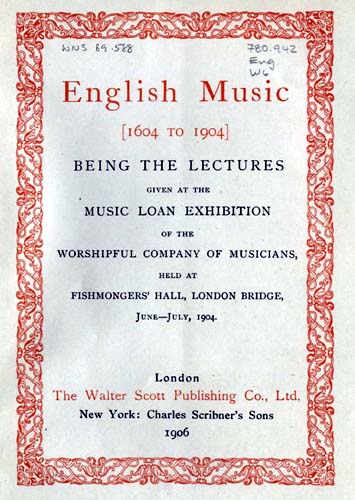
Needless to say, the minute I saw the title page, I had to
have the book! I was, of course, disappointed to discover that there was no reference to
the Group Portrait and certainly no illustration of it in the volume, but, in the Preface,
at the top of Page xii, I did find another bit of information that gave me guarded hope
that I might still be able to determine what the painting that Mr. A. Kummer lent to the
1904 Music Loan Exhibition actually looked like:

It seemed as though two versions of the catalogue were
published, and that one of them was illustrated. I wrote at once to Paula Matthews and
asked if, by some miracle, the Mendel Music Library at Princeton had a copy of the
illustrated version of the catalogue. I did not have an exact description of the
Catalogue, nor was I certain in what year the illustrated version actually appeared, if it
was published at all. After making a diligent search based on the admittedly imprecise
information with which I had provided her, Paula came up with nothing. There did not
appear to be a copy of the illustrated version of the catalogue in the Mendel Music
Library.
Of course, as usual, I had other more pressing matters with
which to contend, but, several months later, on an unseasonably warm afternoon in the
middle of March, 2002, Paula, Seth B. Winner, and I took lunch together in the garden at
Barbetta, things arranged themselves again. We were joined by Ramsey C. El-Assal, a
doctoral candidate in musicology at Princeton. I mentioned my quest for a copy of the
illustrated version of the catalogue for the 1904 Music Loan Exhibition, and Ramsey
volunteered to look for it again. This time, however, he was armed with an additional
important bit of information, namely, that the catalogue did not appear until 1909. A few
days later, I got an e-mail from Ramsey with the welcome news that the Mendel Music
Library did, in fact, have a copy of the illsutrated version of the catalogue.
So, on April 4, 2002, when I traveled to Princeton for the
opening events of the annual conference of the Society for Seventeenth Century Music, the
remarkable and most collegial group of musicologists which sponsors the Journal of Seventeenth Century Music,
I went first to Paula's office to have a look at the catalogue. Ramsey gently broke the
news to me that, while the portrait loaned by Mr. A. Kummer was listed on page 227 of the
illustrated catalogue, there was no illustration of it in the book. I took the thick,
oversized catalogue from him to review the list of the plates. I opened the volume and
turned first to the title page.
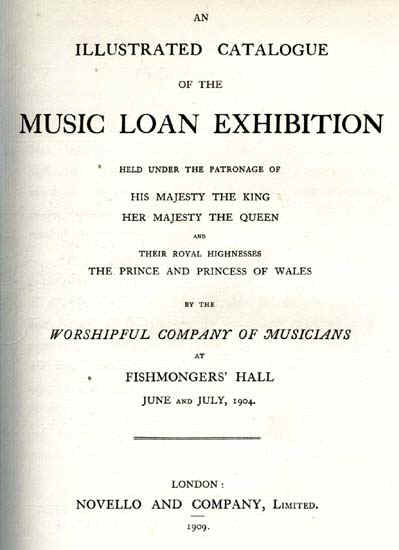
However, almost immediately I turned my attention to the
frontispiece. In fact, when I saw it, my heart almost skipped a beat from eager,
exhilarated anticipation! The frontispiece is a photograph of the exhibition hall,
crammed with display cases, the walls hung high with pictures.

The odds, I decided, were about four in ten that I would find the
painting that belonged to Mr. A. Kummer among those that lined the walls. Paula and
Ramsey both looked on as I carefully perused the frontispiece. It did not take long
to to spot the Group Portrait. In fact, some of you most likely have found it
already. When I spotted it, I let out with a whoop of spontaneous joy that, I am
embarrassed to write, shattered the decorum of the Mendel Music Library. And I
cannot express my gratitude to Ramsey and to Paula forcefully enough for having made the
discovery not only a possibility but also a reality.
The Group Portrait is partially obscured by the display cases,
because it was hung in the lower row of pictures, but it can be discerned clearly,
immediately to the right of the doorway. Here is a detail of that section of the
frontispiece.

The heads of Number Two and Number One Son are clearly visible, and
one can just make out the forehead of Christian Ferdinand Abel, although the rest of him
and all of Number Three Son are obscured by the intervening display case and reflection on
the glass top of that case. Let us get even closer.
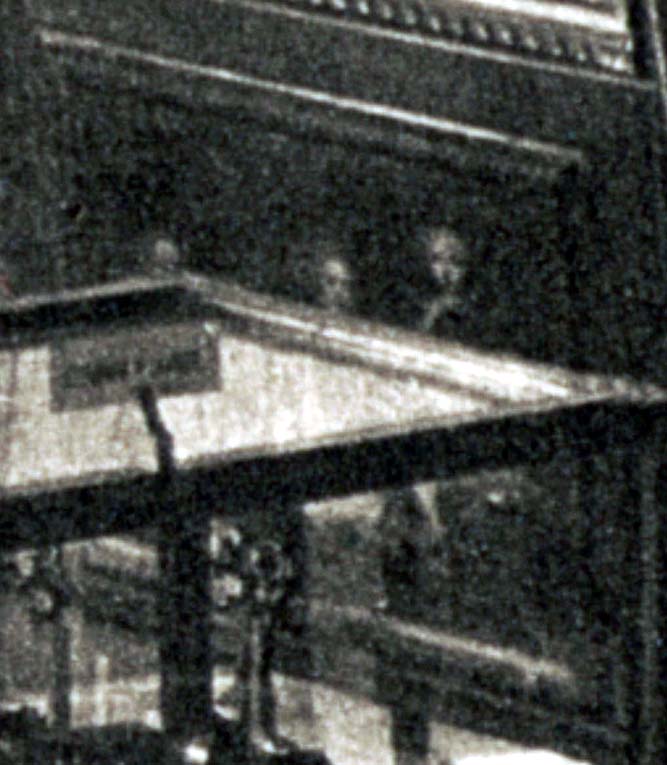
Perhaps more sophisticated scanning and image manipulation programs
than the ones that I have at my disposal would extract more information from the detail,
but grainy though this tremendously enlarged detail is, it still leaves no doubt that we
are dealing with one or the other of the two exemplars of the Group Portrait.
But can we determine which one?
Here is a comparison of Number One Son, the only one of the figures
in the Group Portrait of whom a significant amount can be made out in the frontispiece
photograph. As before, the Bonham's Version is on the left, and the Der Junge
Bach Version is on the right.
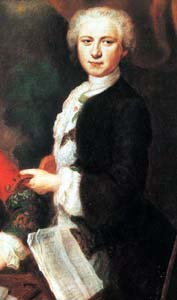

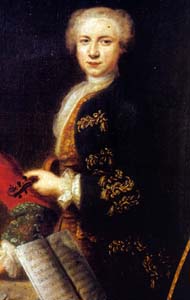
And here are details from within those details, showing just that
portion of Number One Son that is above the obstructing display case in the frontispiece
photograph.



It is difficult, of course, to say for certain, but it appears as
though the Der Junge Bach Version is the one that was displayed at the 1904 Music
Loan Exhibition. Had the Bonham's Version been the one exhibited, the light colored
vest that Number One son is wearing in that version would have blended in with his
elaborate, ruffled shirt to create a larger white area than the viewer encounters in the
1904 Music Loan Exhibition Catalogue frontispiece; the somewhat darker contrasting color
of the waistcoat and the addition of the elaborate and decorative brocade on the jacket in
the Der Junge Bach Version would have caused them to blend in more with the dark
colored jacket than with the white shirt.
Peculiarly enough, a comparison of diminutive scans of the Bonham's
Version and the corresponding detail from the frontispiece photograph seems to emphasize
my conclusion that it was the Der Junge Bach Version that was lent to the 1904
Music Loan Exhibition by Mr. A. Kummer. (Of course, I shall soon make another attempt to
scan the Der Junge Bach Version in a way that will permit some sort of a
reasonable diminutive scan comparison with that image, too. For the moment, I beg the
reader's indulgence and patience, and I offer instead a diminutive version of a detail
that I scanned long before I discovered that I would be called upon to make this
comparison. After all, I want every aspect of this analysis to take place on as
"level a playing ground" as possible. I do not want to appear to be
"stacking the deck"!)
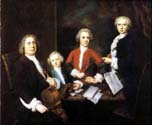


Now let's have a look at the catalogue entry on the Group Portrait,
because it differs significantly from the entry in the catalogue that was published at the
time that the Music Loan Exhibition was held. Please permit me to reiterate what
Oliver Davies wrote to me:
"The reference on p 121 of the catalogue, in a
section labelled 'oil paintings and portraits', reads, in its entirety:
1225. Bach. -- Portrait of a musician and three sons (believed to be the Bach family).
Lent by Mr. A. Kummer."
Here is the description found on page 227 of the
illustrated version of the Catalogue:

The expanded form of the entry makes it even clearer that the
identification of the subjects was tentative, and the addition of the words "members
of" weakens the reader's assumption that it is the Bach family, namely the
family of Sebastian Bach.
These discoveries and additions to our knowledge only serve to
increase the need to learn more about the provenance of both of the exemplars of the
Group Portrait, and I fervently hope that those who may have direct or documentary
knowledge of the obviously complex histories of these images will step forward and help to
fill the gaps and, in the process, either confirm or refute my conclusion that these
portraits depict Christian Ferdinand Abel and three of his sons.
But I have not as yet done with this Addendum.
I am optimistic that significant and substantial progress has been
made in confirming the identity of Number One Son as Leopold August Abel. The reader will
recall that I have had correspondence with the curators of the Museums in Schwerin and
Ludwigslust, where Leopold August Abel, that I had been informed that there were no
portraits of Leopold August Abel in the collections of the museums in Schwerin, and that I
had written again and had asked if there were any images from the period of Leopold August
Abel's service in Ludwigslust that showed the court orchestra or any of the court musical
ensembles.
In early November, 2001, I heard from Prof. Dr. Kornelia Röder of
the Museums in Schwerin, who transmitted this scan of a drawing, apparently in grisaille,
by the Court Painter, Georg Matthieu, that depicts a musical party at Ludwigslust in the
1770s. (Matthieu died in 1778, as I recall)

Of course, the violinist intently reading the performing part on the
candlelit music stand caught my eye at once. Unfortunately, the scan that Prof.
Röder sent is small, but I enlarged the detail of the violinist's head 500% to create a
scan equivalent in size to the "Weydenhammer Equivalents" that I had created of
the head of Number One Son in both the Bonham's Version and the Der Junge Bach
Version of the Group Portrait. Here are the results, and beneath them,
"diminutive" scans in which those Weydenhammer Equivalents have been reduced to
a size equivalent to that of the orginal scan of the Matthieu image:


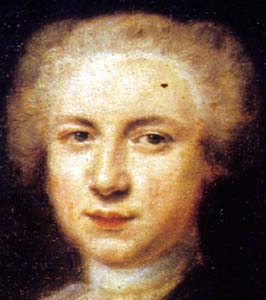



Please note that the unidentified violinist in the Matthieu image has
a large left ear lobe of the same shape as Number One Son's, eybrows of identical shape,
the identical nose structure, and an overbite. Pending further research, of course,
I cautiously but confidently assert that the solo violinist in the Matthieu image and
Number One Son are one and the same, and that both portraits depict Leopold August Abel.
I shall keep you advised of developments with these researches as
they take shape.
Teri Noel Towe, April 24, 2002
Please click on  to go back to Part 1 and review the bad news! {:-{(}
to go back to Part 1 and review the bad news! {:-{(}
Please click on  to return to the Index Page at The Face Of Bach.
to return to the Index Page at The Face Of Bach.
Please click on  to visit the
Johann Sebastian Bach Index Page at Teri Noel Towe's Homepages.
to visit the
Johann Sebastian Bach Index Page at Teri Noel Towe's Homepages.
Please click on the 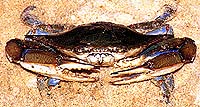 to visit the
Teri Noel Towe Welcome Page.
to visit the
Teri Noel Towe Welcome Page.
TheFaceOfBach@aol.com
Copyright, Teri Noel Towe, 2000, 2001, 2002
Unless otherwise credited, all images of the Weydenhammer Portrait: Copyright, The
Weydenhammer Descendants, 2000
All Rights Reserved
The Face Of Bach is a PPP Free Early Music
website.

The Face Of Bach has received the HIP Woolly Mammoth Stamp of Approval from The HIP-ocrisy Home Page.